Comprehensive Management Accounting Report and Analysis for KEF Ltd.
VerifiedAdded on 2023/01/17
|18
|4778
|37
Report
AI Summary
This report provides a detailed analysis of management accounting practices within KEF Ltd., a medium-sized manufacturing company. The report begins by defining management accounting and its essential requirements, differentiating it from financial accounting and outlining various management accounting systems like cost accounting and inventory management. It then explores different management accounting reports, including performance, budget, and account receivable reports, and explains their interrelation. The core of the report delves into cost accounting techniques, contrasting marginal and absorption costing methods, and demonstrates their application in preparing income statements, along with detailed calculations. The report further examines budgetary control, its types, advantages, and disadvantages, and explores various planning tools for forecasting budgets. Finally, it evaluates how organizations adapt management accounting systems to address financial problems, analyzing how these systems can lead to sustainable success and providing insights into planning tools used to resolve financial issues. The report concludes with a summary of the key findings and references.
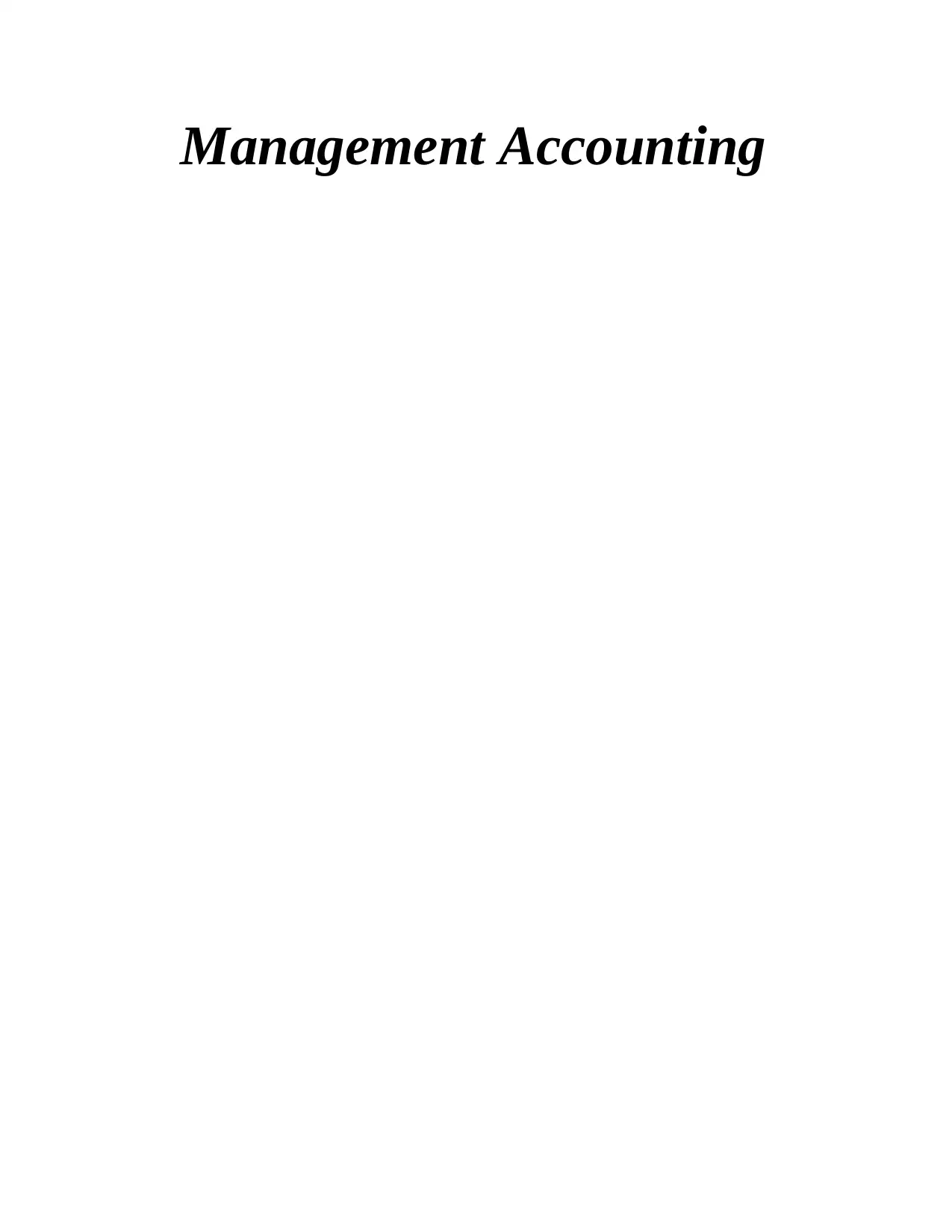
Management Accounting
Paraphrase This Document
Need a fresh take? Get an instant paraphrase of this document with our AI Paraphraser
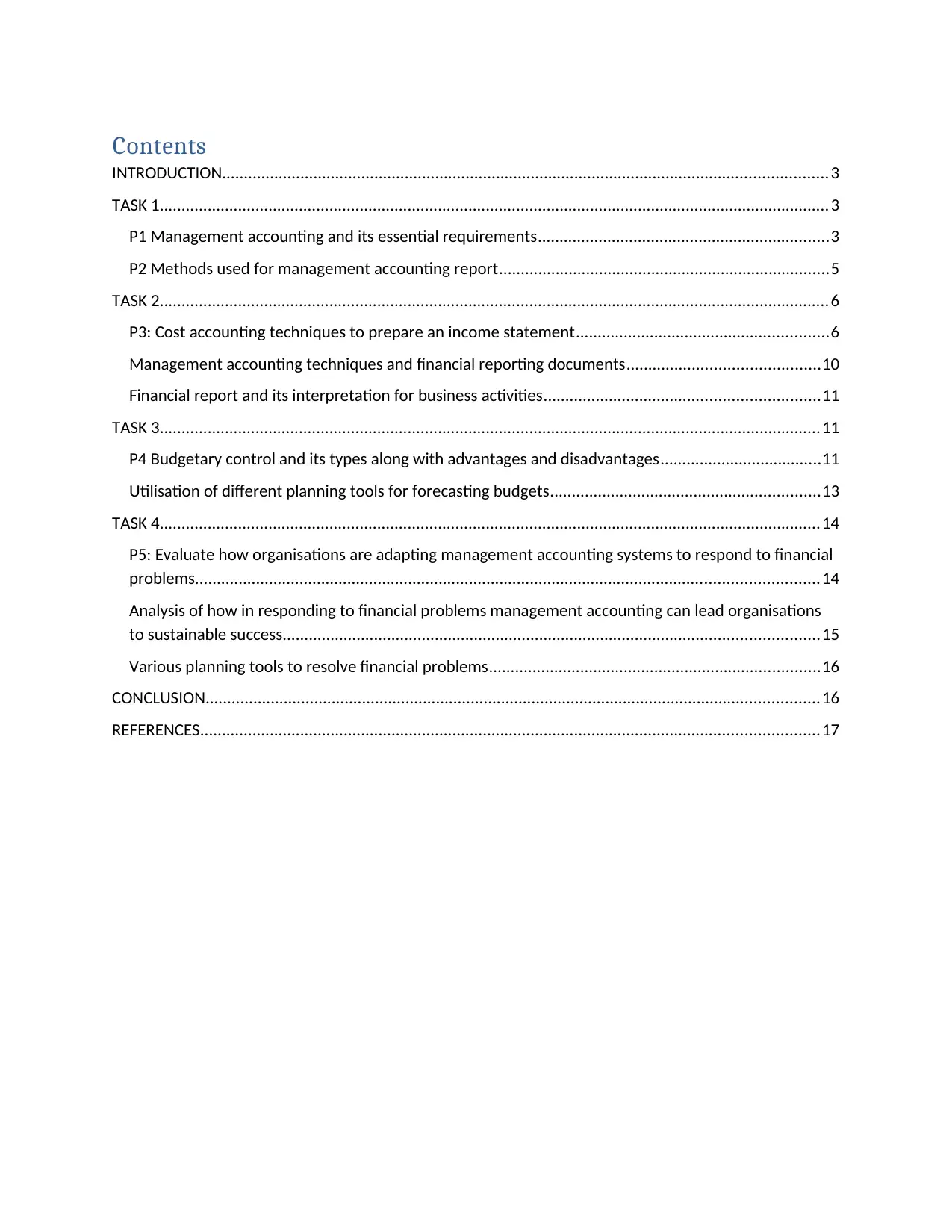
Contents
INTRODUCTION...........................................................................................................................................3
TASK 1..........................................................................................................................................................3
P1 Management accounting and its essential requirements...................................................................3
P2 Methods used for management accounting report............................................................................5
TASK 2..........................................................................................................................................................6
P3: Cost accounting techniques to prepare an income statement..........................................................6
Management accounting techniques and financial reporting documents............................................10
Financial report and its interpretation for business activities...............................................................11
TASK 3........................................................................................................................................................11
P4 Budgetary control and its types along with advantages and disadvantages.....................................11
Utilisation of different planning tools for forecasting budgets..............................................................13
TASK 4........................................................................................................................................................14
P5: Evaluate how organisations are adapting management accounting systems to respond to financial
problems...............................................................................................................................................14
Analysis of how in responding to financial problems management accounting can lead organisations
to sustainable success...........................................................................................................................15
Various planning tools to resolve financial problems............................................................................16
CONCLUSION.............................................................................................................................................16
REFERENCES..............................................................................................................................................17
INTRODUCTION...........................................................................................................................................3
TASK 1..........................................................................................................................................................3
P1 Management accounting and its essential requirements...................................................................3
P2 Methods used for management accounting report............................................................................5
TASK 2..........................................................................................................................................................6
P3: Cost accounting techniques to prepare an income statement..........................................................6
Management accounting techniques and financial reporting documents............................................10
Financial report and its interpretation for business activities...............................................................11
TASK 3........................................................................................................................................................11
P4 Budgetary control and its types along with advantages and disadvantages.....................................11
Utilisation of different planning tools for forecasting budgets..............................................................13
TASK 4........................................................................................................................................................14
P5: Evaluate how organisations are adapting management accounting systems to respond to financial
problems...............................................................................................................................................14
Analysis of how in responding to financial problems management accounting can lead organisations
to sustainable success...........................................................................................................................15
Various planning tools to resolve financial problems............................................................................16
CONCLUSION.............................................................................................................................................16
REFERENCES..............................................................................................................................................17
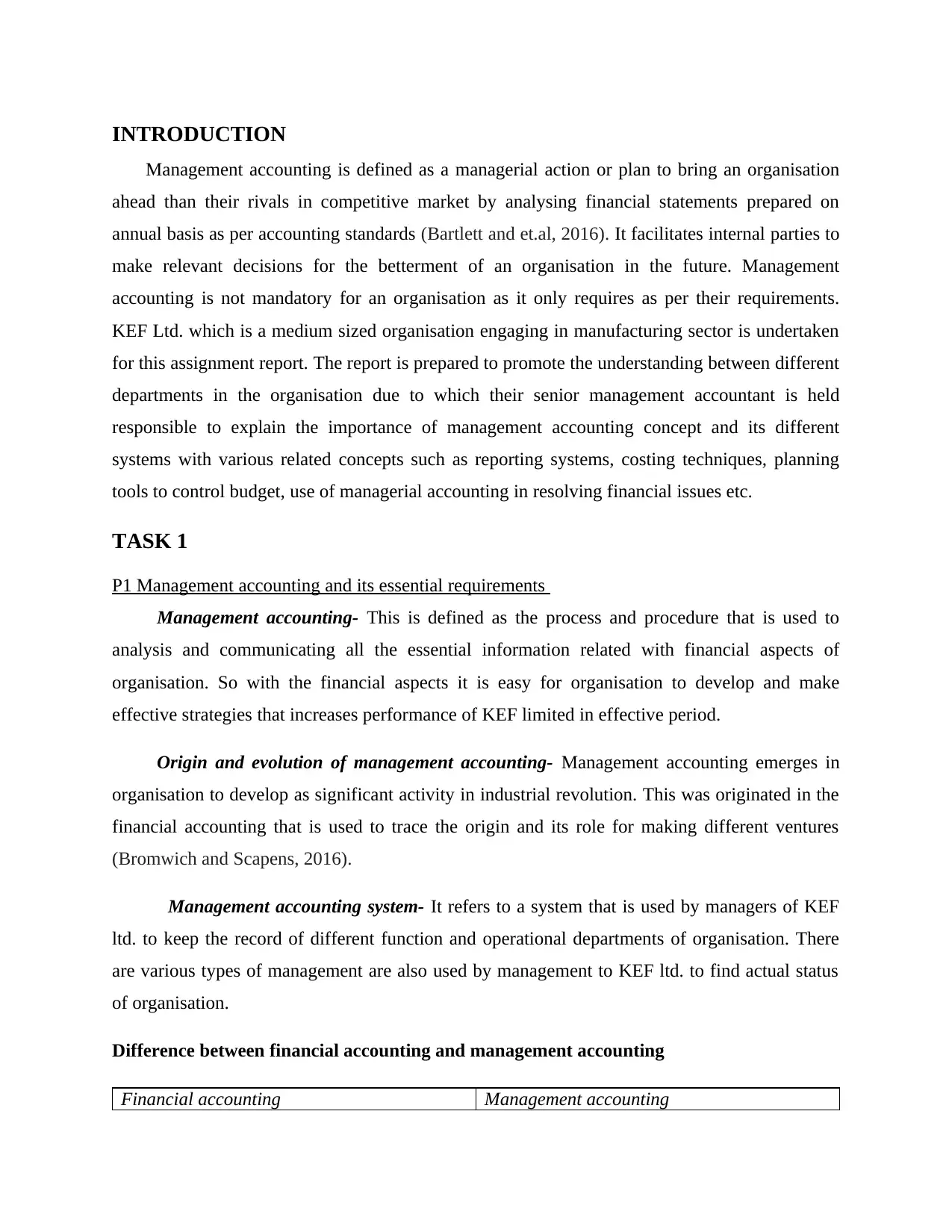
INTRODUCTION
Management accounting is defined as a managerial action or plan to bring an organisation
ahead than their rivals in competitive market by analysing financial statements prepared on
annual basis as per accounting standards (Bartlett and et.al, 2016). It facilitates internal parties to
make relevant decisions for the betterment of an organisation in the future. Management
accounting is not mandatory for an organisation as it only requires as per their requirements.
KEF Ltd. which is a medium sized organisation engaging in manufacturing sector is undertaken
for this assignment report. The report is prepared to promote the understanding between different
departments in the organisation due to which their senior management accountant is held
responsible to explain the importance of management accounting concept and its different
systems with various related concepts such as reporting systems, costing techniques, planning
tools to control budget, use of managerial accounting in resolving financial issues etc.
TASK 1
P1 Management accounting and its essential requirements
Management accounting- This is defined as the process and procedure that is used to
analysis and communicating all the essential information related with financial aspects of
organisation. So with the financial aspects it is easy for organisation to develop and make
effective strategies that increases performance of KEF limited in effective period.
Origin and evolution of management accounting- Management accounting emerges in
organisation to develop as significant activity in industrial revolution. This was originated in the
financial accounting that is used to trace the origin and its role for making different ventures
(Bromwich and Scapens, 2016).
Management accounting system- It refers to a system that is used by managers of KEF
ltd. to keep the record of different function and operational departments of organisation. There
are various types of management are also used by management to KEF ltd. to find actual status
of organisation.
Difference between financial accounting and management accounting
Financial accounting Management accounting
Management accounting is defined as a managerial action or plan to bring an organisation
ahead than their rivals in competitive market by analysing financial statements prepared on
annual basis as per accounting standards (Bartlett and et.al, 2016). It facilitates internal parties to
make relevant decisions for the betterment of an organisation in the future. Management
accounting is not mandatory for an organisation as it only requires as per their requirements.
KEF Ltd. which is a medium sized organisation engaging in manufacturing sector is undertaken
for this assignment report. The report is prepared to promote the understanding between different
departments in the organisation due to which their senior management accountant is held
responsible to explain the importance of management accounting concept and its different
systems with various related concepts such as reporting systems, costing techniques, planning
tools to control budget, use of managerial accounting in resolving financial issues etc.
TASK 1
P1 Management accounting and its essential requirements
Management accounting- This is defined as the process and procedure that is used to
analysis and communicating all the essential information related with financial aspects of
organisation. So with the financial aspects it is easy for organisation to develop and make
effective strategies that increases performance of KEF limited in effective period.
Origin and evolution of management accounting- Management accounting emerges in
organisation to develop as significant activity in industrial revolution. This was originated in the
financial accounting that is used to trace the origin and its role for making different ventures
(Bromwich and Scapens, 2016).
Management accounting system- It refers to a system that is used by managers of KEF
ltd. to keep the record of different function and operational departments of organisation. There
are various types of management are also used by management to KEF ltd. to find actual status
of organisation.
Difference between financial accounting and management accounting
Financial accounting Management accounting
⊘ This is a preview!⊘
Do you want full access?
Subscribe today to unlock all pages.

Trusted by 1+ million students worldwide
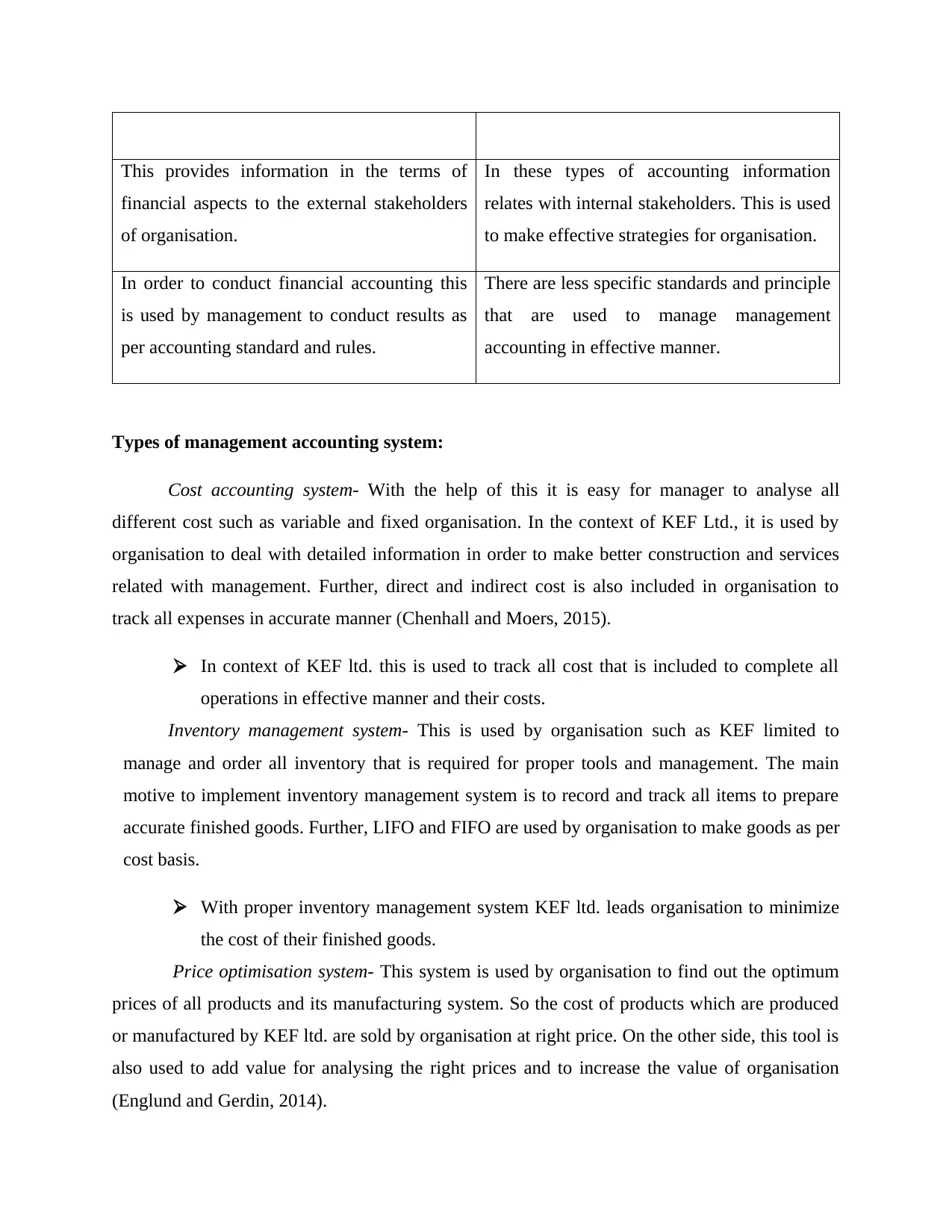
This provides information in the terms of
financial aspects to the external stakeholders
of organisation.
In these types of accounting information
relates with internal stakeholders. This is used
to make effective strategies for organisation.
In order to conduct financial accounting this
is used by management to conduct results as
per accounting standard and rules.
There are less specific standards and principle
that are used to manage management
accounting in effective manner.
Types of management accounting system:
Cost accounting system- With the help of this it is easy for manager to analyse all
different cost such as variable and fixed organisation. In the context of KEF Ltd., it is used by
organisation to deal with detailed information in order to make better construction and services
related with management. Further, direct and indirect cost is also included in organisation to
track all expenses in accurate manner (Chenhall and Moers, 2015).
In context of KEF ltd. this is used to track all cost that is included to complete all
operations in effective manner and their costs.
Inventory management system- This is used by organisation such as KEF limited to
manage and order all inventory that is required for proper tools and management. The main
motive to implement inventory management system is to record and track all items to prepare
accurate finished goods. Further, LIFO and FIFO are used by organisation to make goods as per
cost basis.
With proper inventory management system KEF ltd. leads organisation to minimize
the cost of their finished goods.
Price optimisation system- This system is used by organisation to find out the optimum
prices of all products and its manufacturing system. So the cost of products which are produced
or manufactured by KEF ltd. are sold by organisation at right price. On the other side, this tool is
also used to add value for analysing the right prices and to increase the value of organisation
(Englund and Gerdin, 2014).
financial aspects to the external stakeholders
of organisation.
In these types of accounting information
relates with internal stakeholders. This is used
to make effective strategies for organisation.
In order to conduct financial accounting this
is used by management to conduct results as
per accounting standard and rules.
There are less specific standards and principle
that are used to manage management
accounting in effective manner.
Types of management accounting system:
Cost accounting system- With the help of this it is easy for manager to analyse all
different cost such as variable and fixed organisation. In the context of KEF Ltd., it is used by
organisation to deal with detailed information in order to make better construction and services
related with management. Further, direct and indirect cost is also included in organisation to
track all expenses in accurate manner (Chenhall and Moers, 2015).
In context of KEF ltd. this is used to track all cost that is included to complete all
operations in effective manner and their costs.
Inventory management system- This is used by organisation such as KEF limited to
manage and order all inventory that is required for proper tools and management. The main
motive to implement inventory management system is to record and track all items to prepare
accurate finished goods. Further, LIFO and FIFO are used by organisation to make goods as per
cost basis.
With proper inventory management system KEF ltd. leads organisation to minimize
the cost of their finished goods.
Price optimisation system- This system is used by organisation to find out the optimum
prices of all products and its manufacturing system. So the cost of products which are produced
or manufactured by KEF ltd. are sold by organisation at right price. On the other side, this tool is
also used to add value for analysing the right prices and to increase the value of organisation
(Englund and Gerdin, 2014).
Paraphrase This Document
Need a fresh take? Get an instant paraphrase of this document with our AI Paraphraser
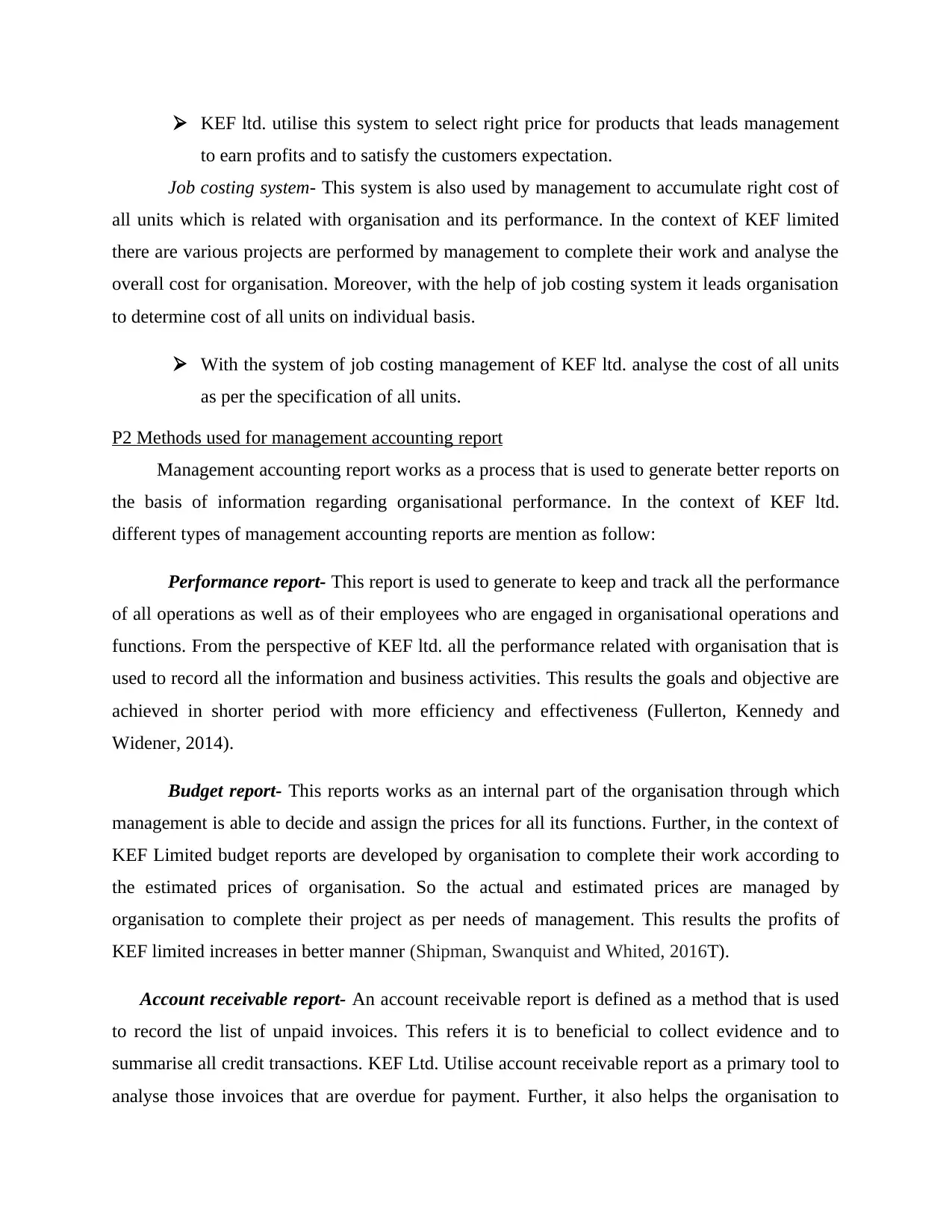
KEF ltd. utilise this system to select right price for products that leads management
to earn profits and to satisfy the customers expectation.
Job costing system- This system is also used by management to accumulate right cost of
all units which is related with organisation and its performance. In the context of KEF limited
there are various projects are performed by management to complete their work and analyse the
overall cost for organisation. Moreover, with the help of job costing system it leads organisation
to determine cost of all units on individual basis.
With the system of job costing management of KEF ltd. analyse the cost of all units
as per the specification of all units.
P2 Methods used for management accounting report
Management accounting report works as a process that is used to generate better reports on
the basis of information regarding organisational performance. In the context of KEF ltd.
different types of management accounting reports are mention as follow:
Performance report- This report is used to generate to keep and track all the performance
of all operations as well as of their employees who are engaged in organisational operations and
functions. From the perspective of KEF ltd. all the performance related with organisation that is
used to record all the information and business activities. This results the goals and objective are
achieved in shorter period with more efficiency and effectiveness (Fullerton, Kennedy and
Widener, 2014).
Budget report- This reports works as an internal part of the organisation through which
management is able to decide and assign the prices for all its functions. Further, in the context of
KEF Limited budget reports are developed by organisation to complete their work according to
the estimated prices of organisation. So the actual and estimated prices are managed by
organisation to complete their project as per needs of management. This results the profits of
KEF limited increases in better manner (Shipman, Swanquist and Whited, 2016T).
Account receivable report- An account receivable report is defined as a method that is used
to record the list of unpaid invoices. This refers it is to beneficial to collect evidence and to
summarise all credit transactions. KEF Ltd. Utilise account receivable report as a primary tool to
analyse those invoices that are overdue for payment. Further, it also helps the organisation to
to earn profits and to satisfy the customers expectation.
Job costing system- This system is also used by management to accumulate right cost of
all units which is related with organisation and its performance. In the context of KEF limited
there are various projects are performed by management to complete their work and analyse the
overall cost for organisation. Moreover, with the help of job costing system it leads organisation
to determine cost of all units on individual basis.
With the system of job costing management of KEF ltd. analyse the cost of all units
as per the specification of all units.
P2 Methods used for management accounting report
Management accounting report works as a process that is used to generate better reports on
the basis of information regarding organisational performance. In the context of KEF ltd.
different types of management accounting reports are mention as follow:
Performance report- This report is used to generate to keep and track all the performance
of all operations as well as of their employees who are engaged in organisational operations and
functions. From the perspective of KEF ltd. all the performance related with organisation that is
used to record all the information and business activities. This results the goals and objective are
achieved in shorter period with more efficiency and effectiveness (Fullerton, Kennedy and
Widener, 2014).
Budget report- This reports works as an internal part of the organisation through which
management is able to decide and assign the prices for all its functions. Further, in the context of
KEF Limited budget reports are developed by organisation to complete their work according to
the estimated prices of organisation. So the actual and estimated prices are managed by
organisation to complete their project as per needs of management. This results the profits of
KEF limited increases in better manner (Shipman, Swanquist and Whited, 2016T).
Account receivable report- An account receivable report is defined as a method that is used
to record the list of unpaid invoices. This refers it is to beneficial to collect evidence and to
summarise all credit transactions. KEF Ltd. Utilise account receivable report as a primary tool to
analyse those invoices that are overdue for payment. Further, it also helps the organisation to
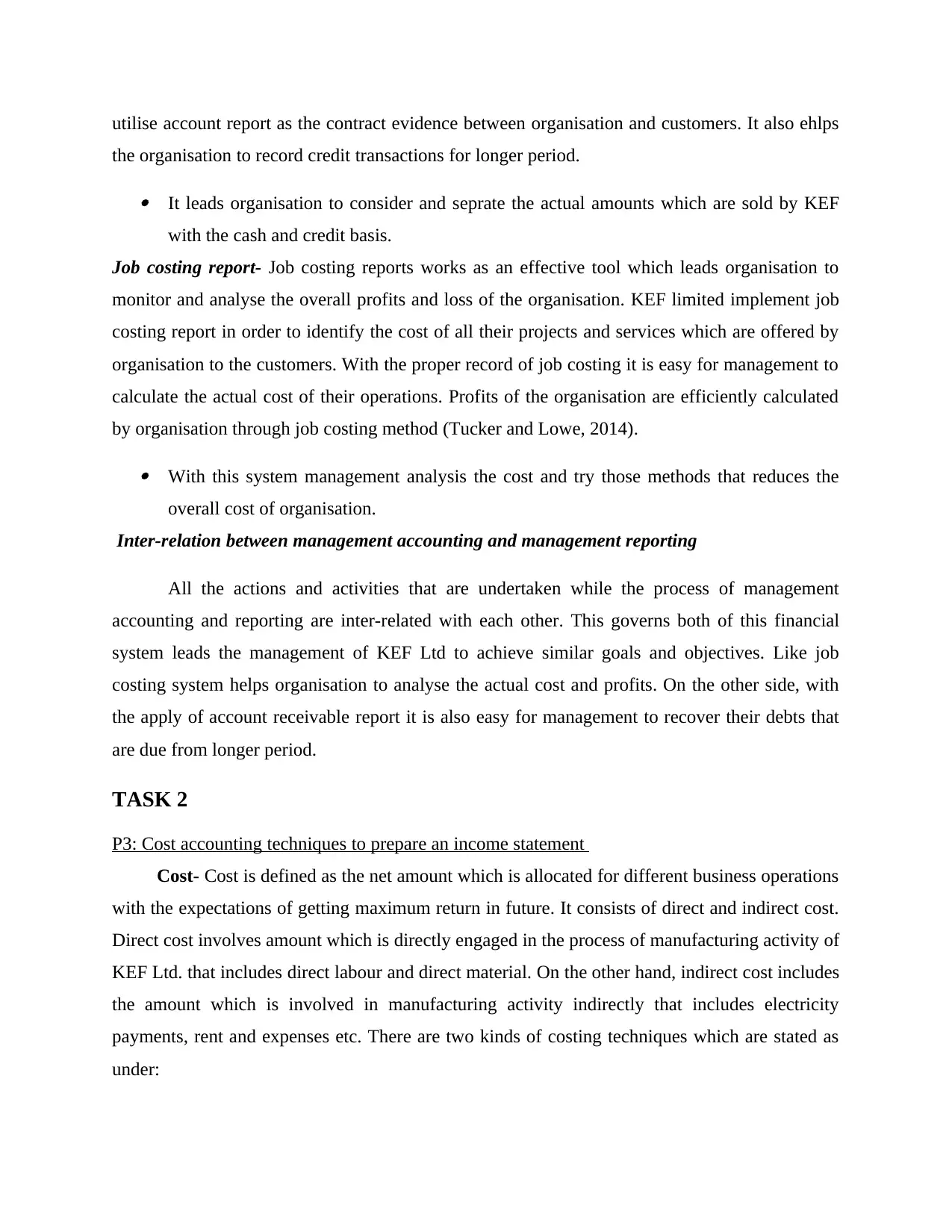
utilise account report as the contract evidence between organisation and customers. It also ehlps
the organisation to record credit transactions for longer period.
It leads organisation to consider and seprate the actual amounts which are sold by KEF
with the cash and credit basis.
Job costing report- Job costing reports works as an effective tool which leads organisation to
monitor and analyse the overall profits and loss of the organisation. KEF limited implement job
costing report in order to identify the cost of all their projects and services which are offered by
organisation to the customers. With the proper record of job costing it is easy for management to
calculate the actual cost of their operations. Profits of the organisation are efficiently calculated
by organisation through job costing method (Tucker and Lowe, 2014).
With this system management analysis the cost and try those methods that reduces the
overall cost of organisation.
Inter-relation between management accounting and management reporting
All the actions and activities that are undertaken while the process of management
accounting and reporting are inter-related with each other. This governs both of this financial
system leads the management of KEF Ltd to achieve similar goals and objectives. Like job
costing system helps organisation to analyse the actual cost and profits. On the other side, with
the apply of account receivable report it is also easy for management to recover their debts that
are due from longer period.
TASK 2
P3: Cost accounting techniques to prepare an income statement
Cost- Cost is defined as the net amount which is allocated for different business operations
with the expectations of getting maximum return in future. It consists of direct and indirect cost.
Direct cost involves amount which is directly engaged in the process of manufacturing activity of
KEF Ltd. that includes direct labour and direct material. On the other hand, indirect cost includes
the amount which is involved in manufacturing activity indirectly that includes electricity
payments, rent and expenses etc. There are two kinds of costing techniques which are stated as
under:
the organisation to record credit transactions for longer period.
It leads organisation to consider and seprate the actual amounts which are sold by KEF
with the cash and credit basis.
Job costing report- Job costing reports works as an effective tool which leads organisation to
monitor and analyse the overall profits and loss of the organisation. KEF limited implement job
costing report in order to identify the cost of all their projects and services which are offered by
organisation to the customers. With the proper record of job costing it is easy for management to
calculate the actual cost of their operations. Profits of the organisation are efficiently calculated
by organisation through job costing method (Tucker and Lowe, 2014).
With this system management analysis the cost and try those methods that reduces the
overall cost of organisation.
Inter-relation between management accounting and management reporting
All the actions and activities that are undertaken while the process of management
accounting and reporting are inter-related with each other. This governs both of this financial
system leads the management of KEF Ltd to achieve similar goals and objectives. Like job
costing system helps organisation to analyse the actual cost and profits. On the other side, with
the apply of account receivable report it is also easy for management to recover their debts that
are due from longer period.
TASK 2
P3: Cost accounting techniques to prepare an income statement
Cost- Cost is defined as the net amount which is allocated for different business operations
with the expectations of getting maximum return in future. It consists of direct and indirect cost.
Direct cost involves amount which is directly engaged in the process of manufacturing activity of
KEF Ltd. that includes direct labour and direct material. On the other hand, indirect cost includes
the amount which is involved in manufacturing activity indirectly that includes electricity
payments, rent and expenses etc. There are two kinds of costing techniques which are stated as
under:
⊘ This is a preview!⊘
Do you want full access?
Subscribe today to unlock all pages.

Trusted by 1+ million students worldwide
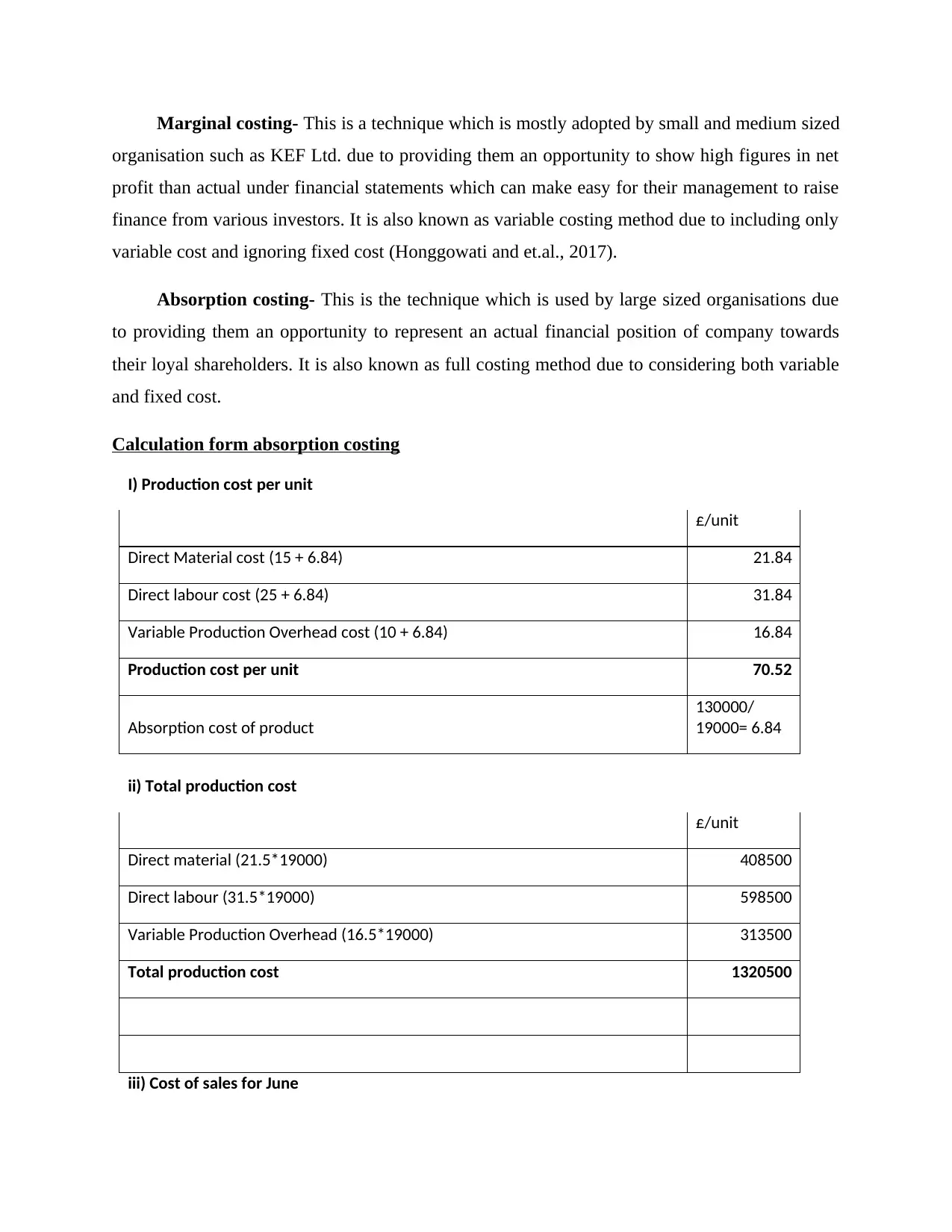
Marginal costing- This is a technique which is mostly adopted by small and medium sized
organisation such as KEF Ltd. due to providing them an opportunity to show high figures in net
profit than actual under financial statements which can make easy for their management to raise
finance from various investors. It is also known as variable costing method due to including only
variable cost and ignoring fixed cost (Honggowati and et.al., 2017).
Absorption costing- This is the technique which is used by large sized organisations due
to providing them an opportunity to represent an actual financial position of company towards
their loyal shareholders. It is also known as full costing method due to considering both variable
and fixed cost.
Calculation form absorption costing
I) Production cost per unit
£/unit
Direct Material cost (15 + 6.84) 21.84
Direct labour cost (25 + 6.84) 31.84
Variable Production Overhead cost (10 + 6.84) 16.84
Production cost per unit 70.52
Absorption cost of product
130000/
19000= 6.84
ii) Total production cost
£/unit
Direct material (21.5*19000) 408500
Direct labour (31.5*19000) 598500
Variable Production Overhead (16.5*19000) 313500
Total production cost 1320500
iii) Cost of sales for June
organisation such as KEF Ltd. due to providing them an opportunity to show high figures in net
profit than actual under financial statements which can make easy for their management to raise
finance from various investors. It is also known as variable costing method due to including only
variable cost and ignoring fixed cost (Honggowati and et.al., 2017).
Absorption costing- This is the technique which is used by large sized organisations due
to providing them an opportunity to represent an actual financial position of company towards
their loyal shareholders. It is also known as full costing method due to considering both variable
and fixed cost.
Calculation form absorption costing
I) Production cost per unit
£/unit
Direct Material cost (15 + 6.84) 21.84
Direct labour cost (25 + 6.84) 31.84
Variable Production Overhead cost (10 + 6.84) 16.84
Production cost per unit 70.52
Absorption cost of product
130000/
19000= 6.84
ii) Total production cost
£/unit
Direct material (21.5*19000) 408500
Direct labour (31.5*19000) 598500
Variable Production Overhead (16.5*19000) 313500
Total production cost 1320500
iii) Cost of sales for June
Paraphrase This Document
Need a fresh take? Get an instant paraphrase of this document with our AI Paraphraser
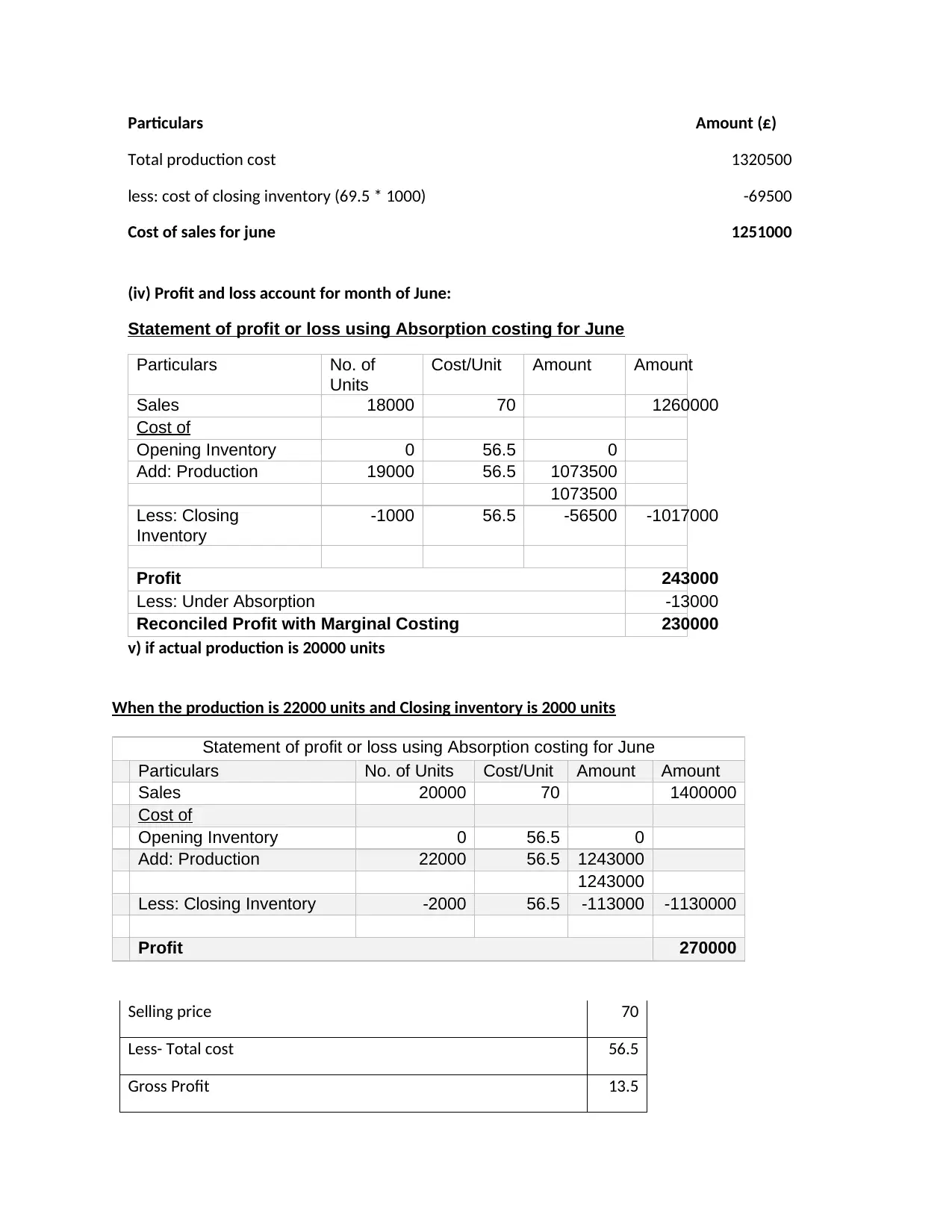
Particulars Amount (£)
Total production cost 1320500
less: cost of closing inventory (69.5 * 1000) -69500
Cost of sales for june 1251000
(iv) Profit and loss account for month of June:
Statement of profit or loss using Absorption costing for June
Particulars No. of
Units
Cost/Unit Amount Amount
Sales 18000 70 1260000
Cost of
Opening Inventory 0 56.5 0
Add: Production 19000 56.5 1073500
1073500
Less: Closing
Inventory
-1000 56.5 -56500 -1017000
Profit 243000
Less: Under Absorption -13000
Reconciled Profit with Marginal Costing 230000
v) if actual production is 20000 units
When the production is 22000 units and Closing inventory is 2000 units
Statement of profit or loss using Absorption costing for June
Particulars No. of Units Cost/Unit Amount Amount
Sales 20000 70 1400000
Cost of
Opening Inventory 0 56.5 0
Add: Production 22000 56.5 1243000
1243000
Less: Closing Inventory -2000 56.5 -113000 -1130000
Profit 270000
Selling price 70
Less- Total cost 56.5
Gross Profit 13.5
Total production cost 1320500
less: cost of closing inventory (69.5 * 1000) -69500
Cost of sales for june 1251000
(iv) Profit and loss account for month of June:
Statement of profit or loss using Absorption costing for June
Particulars No. of
Units
Cost/Unit Amount Amount
Sales 18000 70 1260000
Cost of
Opening Inventory 0 56.5 0
Add: Production 19000 56.5 1073500
1073500
Less: Closing
Inventory
-1000 56.5 -56500 -1017000
Profit 243000
Less: Under Absorption -13000
Reconciled Profit with Marginal Costing 230000
v) if actual production is 20000 units
When the production is 22000 units and Closing inventory is 2000 units
Statement of profit or loss using Absorption costing for June
Particulars No. of Units Cost/Unit Amount Amount
Sales 20000 70 1400000
Cost of
Opening Inventory 0 56.5 0
Add: Production 22000 56.5 1243000
1243000
Less: Closing Inventory -2000 56.5 -113000 -1130000
Profit 270000
Selling price 70
Less- Total cost 56.5
Gross Profit 13.5
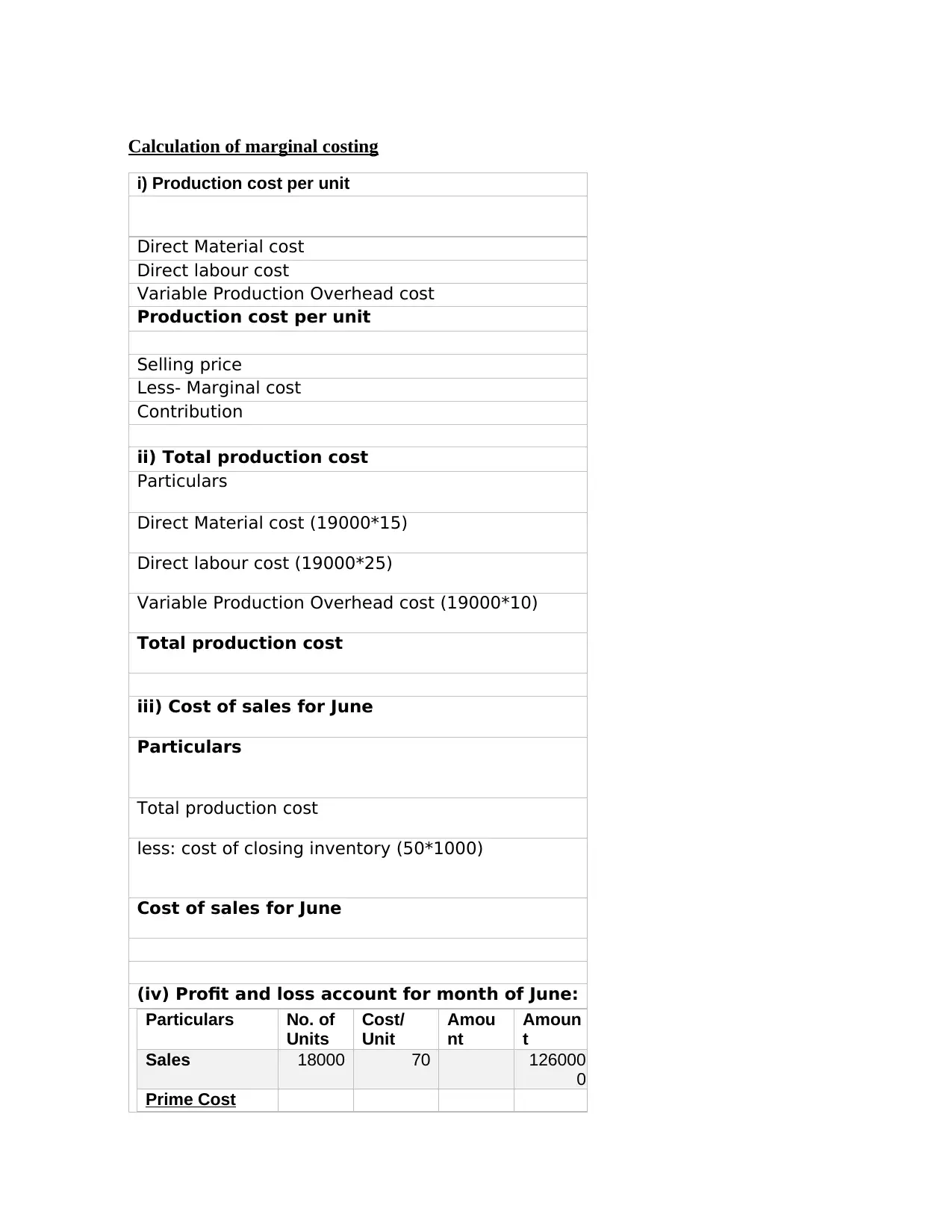
Calculation of marginal costing
i) Production cost per unit
Direct Material cost
Direct labour cost
Variable Production Overhead cost
Production cost per unit
Selling price
Less- Marginal cost
Contribution
ii) Total production cost
Particulars
Direct Material cost (19000*15)
Direct labour cost (19000*25)
Variable Production Overhead cost (19000*10)
Total production cost
iii) Cost of sales for June
Particulars
Total production cost
less: cost of closing inventory (50*1000)
Cost of sales for June
(iv) Profit and loss account for month of June:
Particulars No. of
Units
Cost/
Unit
Amou
nt
Amoun
t
Sales 18000 70 126000
0
Prime Cost
i) Production cost per unit
Direct Material cost
Direct labour cost
Variable Production Overhead cost
Production cost per unit
Selling price
Less- Marginal cost
Contribution
ii) Total production cost
Particulars
Direct Material cost (19000*15)
Direct labour cost (19000*25)
Variable Production Overhead cost (19000*10)
Total production cost
iii) Cost of sales for June
Particulars
Total production cost
less: cost of closing inventory (50*1000)
Cost of sales for June
(iv) Profit and loss account for month of June:
Particulars No. of
Units
Cost/
Unit
Amou
nt
Amoun
t
Sales 18000 70 126000
0
Prime Cost
⊘ This is a preview!⊘
Do you want full access?
Subscribe today to unlock all pages.

Trusted by 1+ million students worldwide
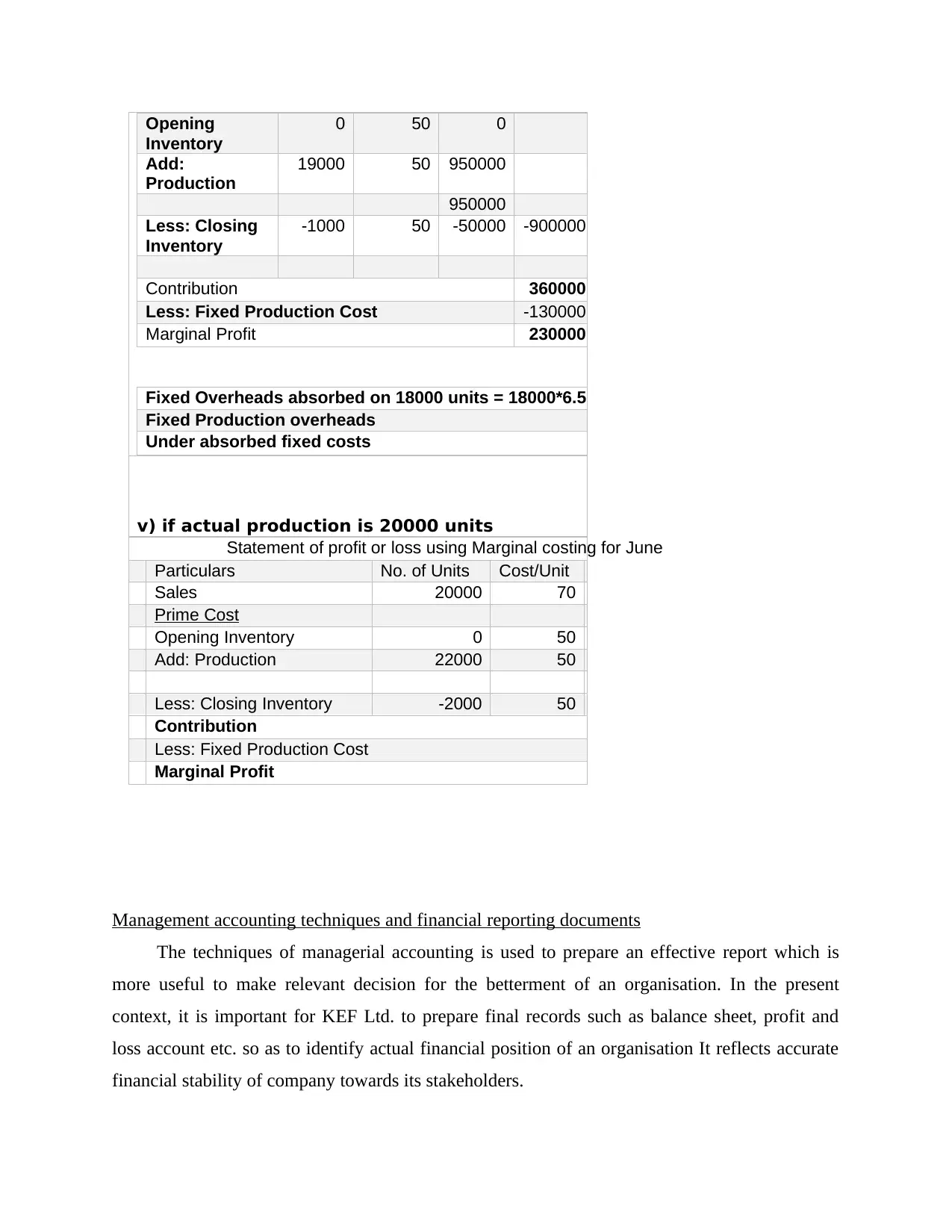
Opening
Inventory
0 50 0
Add:
Production
19000 50 950000
950000
Less: Closing
Inventory
-1000 50 -50000 -900000
Contribution 360000
Less: Fixed Production Cost -130000
Marginal Profit 230000
Fixed Overheads absorbed on 18000 units = 18000*6.5
Fixed Production overheads
Under absorbed fixed costs
v) if actual production is 20000 units
Statement of profit or loss using Marginal costing for June
Particulars No. of Units Cost/Unit
Sales 20000 70
Prime Cost
Opening Inventory 0 50
Add: Production 22000 50
Less: Closing Inventory -2000 50
Contribution
Less: Fixed Production Cost
Marginal Profit
Management accounting techniques and financial reporting documents
The techniques of managerial accounting is used to prepare an effective report which is
more useful to make relevant decision for the betterment of an organisation. In the present
context, it is important for KEF Ltd. to prepare final records such as balance sheet, profit and
loss account etc. so as to identify actual financial position of an organisation It reflects accurate
financial stability of company towards its stakeholders.
Inventory
0 50 0
Add:
Production
19000 50 950000
950000
Less: Closing
Inventory
-1000 50 -50000 -900000
Contribution 360000
Less: Fixed Production Cost -130000
Marginal Profit 230000
Fixed Overheads absorbed on 18000 units = 18000*6.5
Fixed Production overheads
Under absorbed fixed costs
v) if actual production is 20000 units
Statement of profit or loss using Marginal costing for June
Particulars No. of Units Cost/Unit
Sales 20000 70
Prime Cost
Opening Inventory 0 50
Add: Production 22000 50
Less: Closing Inventory -2000 50
Contribution
Less: Fixed Production Cost
Marginal Profit
Management accounting techniques and financial reporting documents
The techniques of managerial accounting is used to prepare an effective report which is
more useful to make relevant decision for the betterment of an organisation. In the present
context, it is important for KEF Ltd. to prepare final records such as balance sheet, profit and
loss account etc. so as to identify actual financial position of an organisation It reflects accurate
financial stability of company towards its stakeholders.
Paraphrase This Document
Need a fresh take? Get an instant paraphrase of this document with our AI Paraphraser
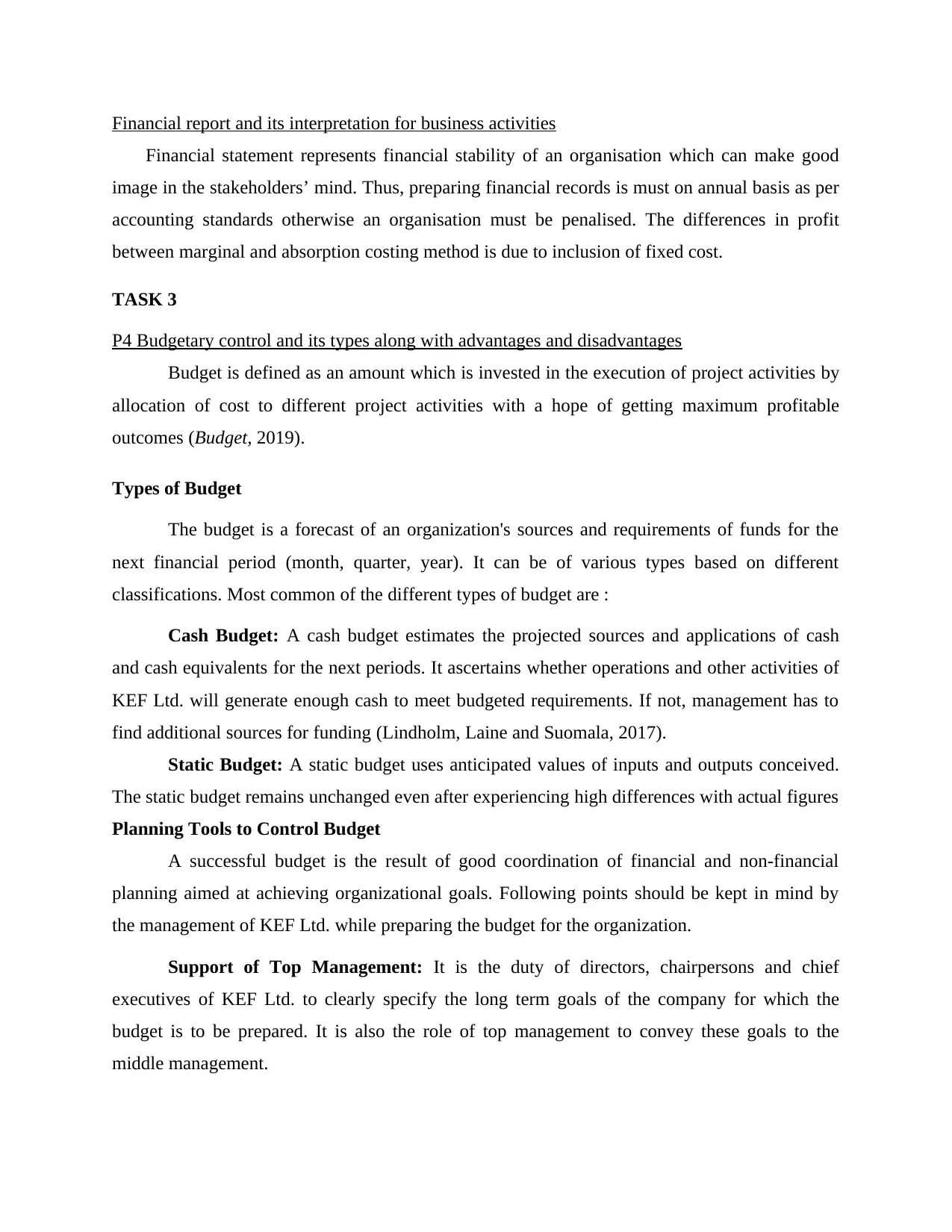
Financial report and its interpretation for business activities
Financial statement represents financial stability of an organisation which can make good
image in the stakeholders’ mind. Thus, preparing financial records is must on annual basis as per
accounting standards otherwise an organisation must be penalised. The differences in profit
between marginal and absorption costing method is due to inclusion of fixed cost.
TASK 3
P4 Budgetary control and its types along with advantages and disadvantages
Budget is defined as an amount which is invested in the execution of project activities by
allocation of cost to different project activities with a hope of getting maximum profitable
outcomes (Budget, 2019).
Types of Budget
The budget is a forecast of an organization's sources and requirements of funds for the
next financial period (month, quarter, year). It can be of various types based on different
classifications. Most common of the different types of budget are :
Cash Budget: A cash budget estimates the projected sources and applications of cash
and cash equivalents for the next periods. It ascertains whether operations and other activities of
KEF Ltd. will generate enough cash to meet budgeted requirements. If not, management has to
find additional sources for funding (Lindholm, Laine and Suomala, 2017).
Static Budget: A static budget uses anticipated values of inputs and outputs conceived.
The static budget remains unchanged even after experiencing high differences with actual figures
Planning Tools to Control Budget
A successful budget is the result of good coordination of financial and non-financial
planning aimed at achieving organizational goals. Following points should be kept in mind by
the management of KEF Ltd. while preparing the budget for the organization.
Support of Top Management: It is the duty of directors, chairpersons and chief
executives of KEF Ltd. to clearly specify the long term goals of the company for which the
budget is to be prepared. It is also the role of top management to convey these goals to the
middle management.
Financial statement represents financial stability of an organisation which can make good
image in the stakeholders’ mind. Thus, preparing financial records is must on annual basis as per
accounting standards otherwise an organisation must be penalised. The differences in profit
between marginal and absorption costing method is due to inclusion of fixed cost.
TASK 3
P4 Budgetary control and its types along with advantages and disadvantages
Budget is defined as an amount which is invested in the execution of project activities by
allocation of cost to different project activities with a hope of getting maximum profitable
outcomes (Budget, 2019).
Types of Budget
The budget is a forecast of an organization's sources and requirements of funds for the
next financial period (month, quarter, year). It can be of various types based on different
classifications. Most common of the different types of budget are :
Cash Budget: A cash budget estimates the projected sources and applications of cash
and cash equivalents for the next periods. It ascertains whether operations and other activities of
KEF Ltd. will generate enough cash to meet budgeted requirements. If not, management has to
find additional sources for funding (Lindholm, Laine and Suomala, 2017).
Static Budget: A static budget uses anticipated values of inputs and outputs conceived.
The static budget remains unchanged even after experiencing high differences with actual figures
Planning Tools to Control Budget
A successful budget is the result of good coordination of financial and non-financial
planning aimed at achieving organizational goals. Following points should be kept in mind by
the management of KEF Ltd. while preparing the budget for the organization.
Support of Top Management: It is the duty of directors, chairpersons and chief
executives of KEF Ltd. to clearly specify the long term goals of the company for which the
budget is to be prepared. It is also the role of top management to convey these goals to the
middle management.
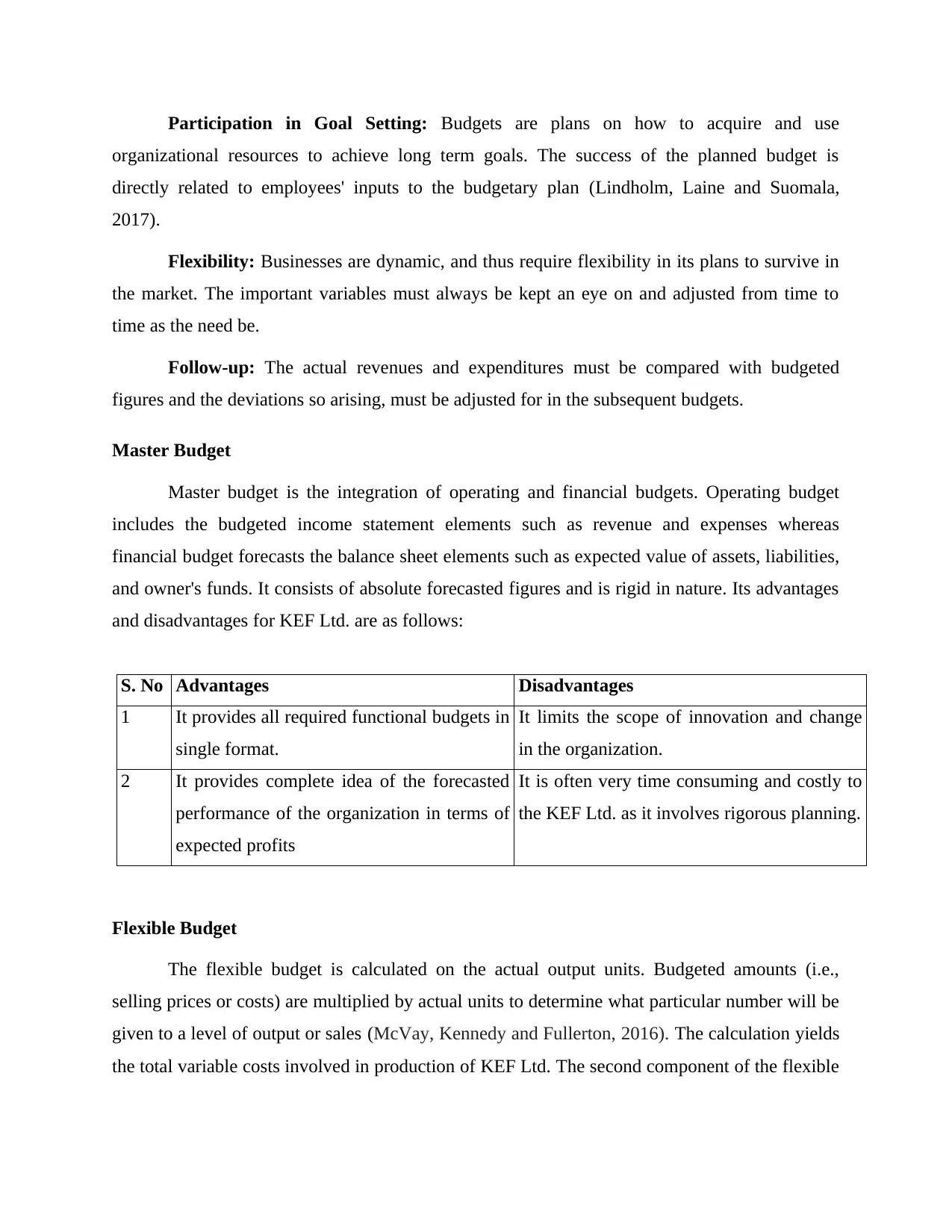
Participation in Goal Setting: Budgets are plans on how to acquire and use
organizational resources to achieve long term goals. The success of the planned budget is
directly related to employees' inputs to the budgetary plan (Lindholm, Laine and Suomala,
2017).
Flexibility: Businesses are dynamic, and thus require flexibility in its plans to survive in
the market. The important variables must always be kept an eye on and adjusted from time to
time as the need be.
Follow-up: The actual revenues and expenditures must be compared with budgeted
figures and the deviations so arising, must be adjusted for in the subsequent budgets.
Master Budget
Master budget is the integration of operating and financial budgets. Operating budget
includes the budgeted income statement elements such as revenue and expenses whereas
financial budget forecasts the balance sheet elements such as expected value of assets, liabilities,
and owner's funds. It consists of absolute forecasted figures and is rigid in nature. Its advantages
and disadvantages for KEF Ltd. are as follows:
S. No Advantages Disadvantages
1 It provides all required functional budgets in
single format.
It limits the scope of innovation and change
in the organization.
2 It provides complete idea of the forecasted
performance of the organization in terms of
expected profits
It is often very time consuming and costly to
the KEF Ltd. as it involves rigorous planning.
Flexible Budget
The flexible budget is calculated on the actual output units. Budgeted amounts (i.e.,
selling prices or costs) are multiplied by actual units to determine what particular number will be
given to a level of output or sales (McVay, Kennedy and Fullerton, 2016). The calculation yields
the total variable costs involved in production of KEF Ltd. The second component of the flexible
organizational resources to achieve long term goals. The success of the planned budget is
directly related to employees' inputs to the budgetary plan (Lindholm, Laine and Suomala,
2017).
Flexibility: Businesses are dynamic, and thus require flexibility in its plans to survive in
the market. The important variables must always be kept an eye on and adjusted from time to
time as the need be.
Follow-up: The actual revenues and expenditures must be compared with budgeted
figures and the deviations so arising, must be adjusted for in the subsequent budgets.
Master Budget
Master budget is the integration of operating and financial budgets. Operating budget
includes the budgeted income statement elements such as revenue and expenses whereas
financial budget forecasts the balance sheet elements such as expected value of assets, liabilities,
and owner's funds. It consists of absolute forecasted figures and is rigid in nature. Its advantages
and disadvantages for KEF Ltd. are as follows:
S. No Advantages Disadvantages
1 It provides all required functional budgets in
single format.
It limits the scope of innovation and change
in the organization.
2 It provides complete idea of the forecasted
performance of the organization in terms of
expected profits
It is often very time consuming and costly to
the KEF Ltd. as it involves rigorous planning.
Flexible Budget
The flexible budget is calculated on the actual output units. Budgeted amounts (i.e.,
selling prices or costs) are multiplied by actual units to determine what particular number will be
given to a level of output or sales (McVay, Kennedy and Fullerton, 2016). The calculation yields
the total variable costs involved in production of KEF Ltd. The second component of the flexible
⊘ This is a preview!⊘
Do you want full access?
Subscribe today to unlock all pages.

Trusted by 1+ million students worldwide
1 out of 18
Related Documents
Your All-in-One AI-Powered Toolkit for Academic Success.
+13062052269
info@desklib.com
Available 24*7 on WhatsApp / Email
![[object Object]](/_next/static/media/star-bottom.7253800d.svg)
Unlock your academic potential
Copyright © 2020–2025 A2Z Services. All Rights Reserved. Developed and managed by ZUCOL.





